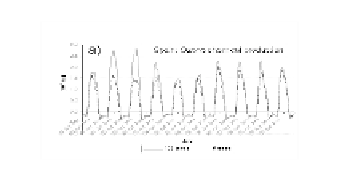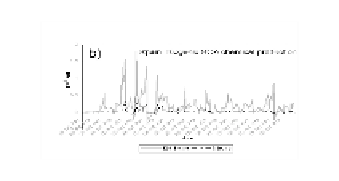Environmental Engineering Reference
In-Depth Information
Fig. 2.
Ozone (a) and SOA (b) Production (positive) and Destruction (negative) due to gas-phase
chemistry simulated with RCG for a 120 × 120 km (area) × 3 km (height) chosen volume over
central Spain. Units are 10
5
kg; gray continuous line: detailed forest inventory; black dashed line:
surrogate trees
to simulate the actual air pollution situation much better than with only the 6
surrogate tree species. During the rest of the period, the differences in the chemistry
due to different amount of forest information is negligible because terpene emis-
sions become less for lower temperatures and overcast sky.
Figure 2b s
hows the
hourly production of biogenic secondary organic carbons, simulated with RCG,
with biogenic emissions estimated with a detailed tree data-base (gray continuous
line) and with the six surrogate tree species data-base. The production rate in the
considered period over the control volume in Spain is factor 3 higher when consider-
ing all available tree information. RCG with surrogate tree species is much less
reactive and thus gives much less secondary organic aerosol production than with
the full 126 tree data-set. The introduction of higher amounts of terpene, isoprene
and thus in general of more volatile organic carbons into the model system not
only produces more ozone and secondary organic aerosol concentrations, but it
makes the whole chemistry more reactive. This influences also the production of
inorganic secondary aerosols, for instance. The more detailed tree species database
emission estimate is responsible for approximately 20% higher nitrate concentrations
over the Milan metropolitan area and over the London-the Netherlands-German
Ruhr belt for the considered period.
4. Conclusion
The comparison between simulations and observations of ozone in southern
Europe has shown a better agreement when biogenic emissions are derived from a
comprehensive forest database. This suggests that RCG describes the oxidation
processes better. The model prediction of biogenic secondary organic aerosols
especially over Northern Europe over the Alps and Balkans gives some 2 µg/m³
higher concentrations with all available tree information than with 6 surrogate tree
information. Especially in these regions the contribution of biogenic secondary
organic aerosols with biogenic VOC as direct precursors is more the 70%. It could
be shown that the chemistry production process simulation in RCG is enhanced
when all tree information is used. This holds for Ozone, and it could be proved


